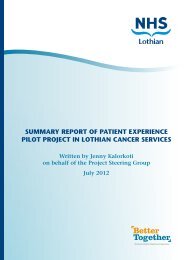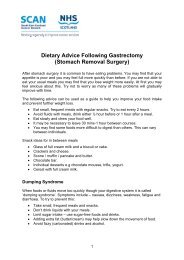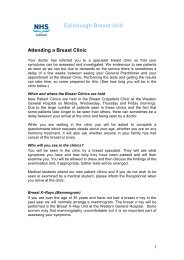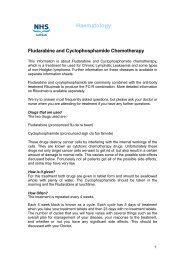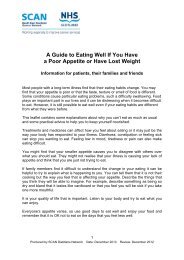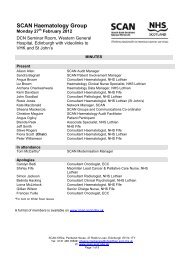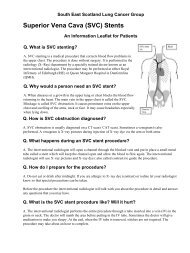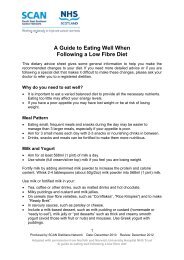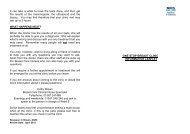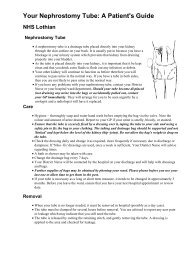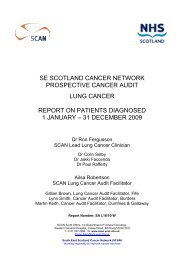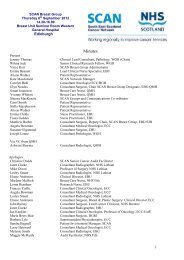Radiologically Inserted Gastrostomy Feeding Tube (RIG ... - SCAN
Radiologically Inserted Gastrostomy Feeding Tube (RIG ... - SCAN
Radiologically Inserted Gastrostomy Feeding Tube (RIG ... - SCAN
You also want an ePaper? Increase the reach of your titles
YUMPU automatically turns print PDFs into web optimized ePapers that Google loves.
<strong>Radiologically</strong> <strong>Inserted</strong> <strong>Gastrostomy</strong><br />
<strong>Feeding</strong> <strong>Tube</strong> (<strong>RIG</strong>)<br />
Information for Patients and Carers<br />
Medicina <strong>RIG</strong><br />
What is a <strong>Radiologically</strong> <strong>Inserted</strong> <strong>Gastrostomy</strong> (<strong>RIG</strong>) and why do I<br />
need one?<br />
A <strong>RIG</strong> is a feeding tube placed directly into your stomach, which allows you<br />
to receive liquid feed, water and sometimes medicines. The tube is held in<br />
place with “stitches” for the first seven days. Thereafter the “ stitches” will<br />
be removed by a member of your health care team.<br />
You may require a <strong>RIG</strong> tube: -<br />
• if you are unable to take enough food and drink to maintain your<br />
weight and nutrition<br />
• prior to planned treatment during which it is anticipated that you may<br />
have difficulty with eating and swallowing.
How is the tube inserted?<br />
The tube is inserted at your hospital and you will usually have some<br />
sedation (medicine to make you drowsy) and local anaesthetic at time of<br />
tube placement. The whole process takes about 45 minutes. If you have<br />
any discomfort after the procedure, you will be given medicines to help the<br />
pain. As with any other procedure there are some risks involved. The<br />
procedure and any risks will be discussed with you before the tube is<br />
placed.<br />
Will I be able to have a bath or shower after the procedure?<br />
For the first two weeks, do not have a bath. Showers are permitted from 24<br />
hours after the procedure. Wash the area of skin around the tube (<strong>RIG</strong><br />
site) first before moving on to other parts of the body. Wash with soap and<br />
water, rinse and dry thoroughly. Check the area for redness, swelling and<br />
bleeding. If you have any concerns, contact your nurse or GP.<br />
How long will I be in hospital?<br />
We usually recommend coming in to hospital the night before the<br />
procedure, to give time for routine blood tests to be taken. The length of<br />
stay will vary from person to person. It will depend on how well you feel<br />
after the procedure. If you are having the <strong>RIG</strong> placed before treatment and<br />
are eating well, your stay may be as short as one or two nights. If you are<br />
having difficulty with eating and drinking, feeding through the tube may<br />
need to be started straight away, and this may entail a longer stay.<br />
Will I still be able to eat and drink?<br />
You will be advised whether you are able to continue to eat and drink after<br />
the tube is placed.<br />
<strong>Feeding</strong><br />
• The dietitian will discuss with you the method and timing of<br />
feeding to suit you best.<br />
• Never put anything other than your prescribed feed, water or<br />
prescribed medicines down your <strong>RIG</strong> tube
Medicines<br />
• Do not lie completely flat when feeding. Support your upper<br />
body with pillows or cushion.<br />
If you have been advised to take your medicines through your tube further<br />
advice will be given on this.<br />
How long will I need the tube for?<br />
This is difficult to estimate and depends on the reason for <strong>RIG</strong> placement.<br />
Before the tube is removed it is important to ensure that you are able to eat<br />
sufficient amounts to maintain your weight. You will be closely monitored<br />
by your dietitian who will advise if feeding can be stopped.<br />
What do I do if I have a problem?<br />
Before you leave hospital, you will be given training and written information<br />
on how to care for the tube, and contact numbers to phone if you have any<br />
difficulties.<br />
Discharge Supplies<br />
On discharge from hospital you will be given a seven day supply of all the<br />
necessary feed and equipment. e.g. dressings, syringes.<br />
Note: The information in this leaflet is intended only as a general guide. It<br />
should not replace the advice of your doctor or health care team.<br />
Produced by <strong>SCAN</strong> Dietitians Network<br />
Pictures used with kind permission from Medicina<br />
Date: October 2009<br />
Review: October 2011



